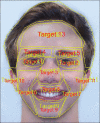Evaluation of the perception of smile esthetics, in frontal view, with mandibular laterognatism, through the eye-tracking technique
- PMID: 33110766
- PMCID: PMC7585464
- DOI: 10.4103/jos.JOS_66_19
Evaluation of the perception of smile esthetics, in frontal view, with mandibular laterognatism, through the eye-tracking technique
Abstract
Objectives: To evaluate the perception of esthetics and the attractiveness of the smile, in frontal view, with mandibular asymmetry, through the eye-tracking.
Materials and methods: OGAMA software and The Eye Tribe Tracker hardware were used to obtain eye tracking in certain areas of interest on the face. To simulate asymmetry, Photoshop® image editing software was used to create a vertical reference line to the midline of the face and make it symmetrical with control of the angulation relative to another horizontal reference line passing through the vertices. Then, the lower third of the face added asymmetries or deviations, starting from zero, with increments of 2 by 2 degrees up to 6 degrees. The study included 60 laypeople, 30 males and 30 females, without any knowledge about the study, showing good vision, and not having used drugs with the possibility of influencing cognitive or motor skills.
Results: From the heat map in cases of mandibular asymmetry, it is possible to visualize that for both sexes the evaluators evaluated with a certain degree of similarity mainly when the deviations presented with 6 degrees. The trajectory of the male and female gaze in cases with asymmetry shows that in cases with a magnitude of 6 degrees, the raters traced mainly in the region of the mouth with little transition in the eye region and mainly in the areas of interest considered as "other." In the images presented with a magnitude of up to 4 degrees, they were traced in the general image.
Conclusions: The perception of laypeople from mandibular asymmetry to the right in females presented a higher perception when compared to males with mandible asymmetry to the left.
Keywords: Eye-tracking; facial asymmetry; smile esthetics.
Copyright: © 2020 Journal of Orthodontic Science.
Conflict of interest statement
There are no conflicts of interest.
Figures






Similar articles
-
Visual facial perception of postsurgical cleft lip scarring assessed by laypeople via eye-tracking.J Orthod Sci. 2021 Oct 15;10:20. doi: 10.4103/jos.JOS_76_20. eCollection 2021. J Orthod Sci. 2021. PMID: 34760813 Free PMC article.
-
The impact of dental midline angulation towards the facial flow curve on the esthetics of an asymmetric face: Perspective of laypeople and orthodontists.J Esthet Restor Dent. 2024 May;36(5):778-784. doi: 10.1111/jerd.13177. Epub 2023 Dec 7. J Esthet Restor Dent. 2024. PMID: 38059402
-
Visual perception of repaired cleft lip scarring face associated with different malocclusions via eye-tracking.J Dent Res Dent Clin Dent Prospects. 2022 Winter;16(1):45-52. doi: 10.34172/joddd.2022.008. Epub 2022 May 29. J Dent Res Dent Clin Dent Prospects. 2022. PMID: 35936939 Free PMC article.
-
Assessing the influence of asymmeftry affecting the mandible and chin point on perceived attractiveness in the orthognathic patient, clinician, and layperson.J Oral Maxillofac Surg. 2012 Jan;70(1):192-206. doi: 10.1016/j.joms.2010.12.055. Epub 2011 May 14. J Oral Maxillofac Surg. 2012. PMID: 21571417
-
Influence of maxillary canine gingival margin asymmetries on the perception of smile esthetics among orthodontists and laypersons.Am J Orthod Dentofacial Orthop. 2014 Jan;145(1):55-63. doi: 10.1016/j.ajodo.2013.09.010. Am J Orthod Dentofacial Orthop. 2014. PMID: 24373655
Cited by
-
Role of Dentofacial Harmony among Young and Old Adult Females in Smile Perception of Dental Specialists and Laypeople: A Cross-Sectional Study.J Pharm Bioallied Sci. 2023 Jul;15(Suppl 1):S588-S594. doi: 10.4103/jpbs.jpbs_661_22. Epub 2023 Jul 5. J Pharm Bioallied Sci. 2023. PMID: 37654305 Free PMC article.
-
The visual perception of aligned and crowded maxillary lateral incisors when smiling via eye tracking.J Dent Res Dent Clin Dent Prospects. 2022 Fall;16(4):234-237. doi: 10.34172/joddd.2022.037. Epub 2022 Dec 30. J Dent Res Dent Clin Dent Prospects. 2022. PMID: 37560490 Free PMC article.
-
Visual facial perception of postsurgical cleft lip scarring assessed by laypeople via eye-tracking.J Orthod Sci. 2021 Oct 15;10:20. doi: 10.4103/jos.JOS_76_20. eCollection 2021. J Orthod Sci. 2021. PMID: 34760813 Free PMC article.
References
-
- Martin AJ, Buschang PH, Boley JC, Taylor RW, McKinney TW. The impact of buccal corridors on smile attractiveness. Eur J Orthod. 2007;29:530–7. - PubMed
-
- Abu Alhaija ES, Al-Shamsi NO, Al-Khateeb S. Perceptions of Jordanian laypersons and dental professionals to altered smile aesthetics. Eur J Orthod. 2011;33:450–6. - PubMed
-
- Ioi H, Kang S, Shimomura T, Kim SS, Park SB, Son WS, et al. Effects of buccal corridors on smile esthetics in Japanese and Korean orthodontists and orthodontic patients. Am J Orthod Dentofacial Orthop. 2012;142:459–65. - PubMed
-
- Câmara CALP. Estética em ortodontia: Diagramas de referências estéticas dentárias (DRED) e faciais (DREF) Rev Dental Press Ortod Ortop Facial. 2006;11:130–56.
LinkOut - more resources
Full Text Sources
